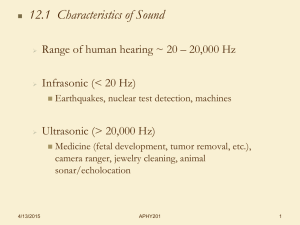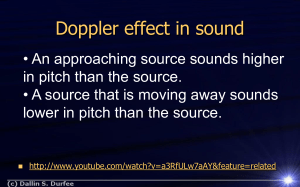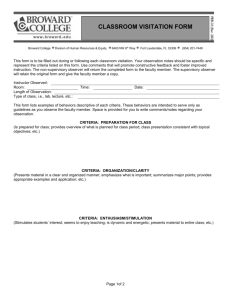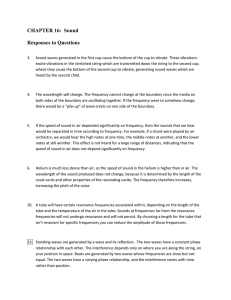Practice Problems (Examples)
advertisement
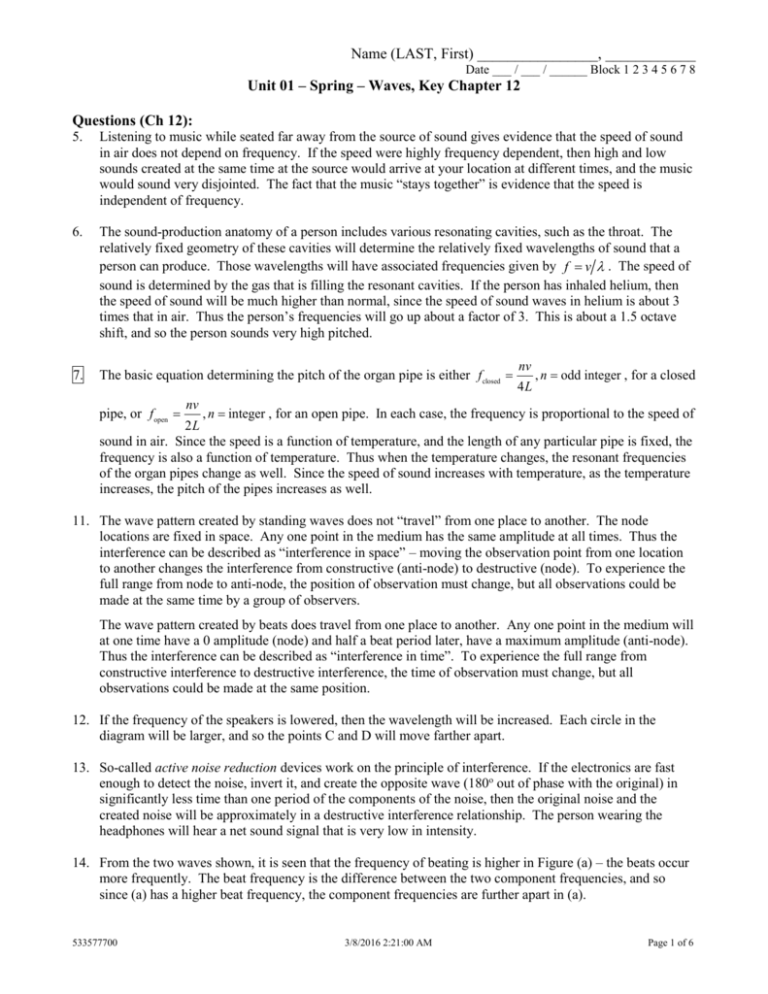
Name (LAST, First) ________________, ____________ Date ___ / ___ / ______ Block 1 2 3 4 5 6 7 8 Unit 01 – Spring – Waves, Key Chapter 12 Questions (Ch 12): 5. Listening to music while seated far away from the source of sound gives evidence that the speed of sound in air does not depend on frequency. If the speed were highly frequency dependent, then high and low sounds created at the same time at the source would arrive at your location at different times, and the music would sound very disjointed. The fact that the music “stays together” is evidence that the speed is independent of frequency. 6. The sound-production anatomy of a person includes various resonating cavities, such as the throat. The relatively fixed geometry of these cavities will determine the relatively fixed wavelengths of sound that a person can produce. Those wavelengths will have associated frequencies given by f v . The speed of sound is determined by the gas that is filling the resonant cavities. If the person has inhaled helium, then the speed of sound will be much higher than normal, since the speed of sound waves in helium is about 3 times that in air. Thus the person’s frequencies will go up about a factor of 3. This is about a 1.5 octave shift, and so the person sounds very high pitched. 7. The basic equation determining the pitch of the organ pipe is either f closed pipe, or f open nv 4L , n odd integer , for a closed nv , n integer , for an open pipe. In each case, the frequency is proportional to the speed of 2L sound in air. Since the speed is a function of temperature, and the length of any particular pipe is fixed, the frequency is also a function of temperature. Thus when the temperature changes, the resonant frequencies of the organ pipes change as well. Since the speed of sound increases with temperature, as the temperature increases, the pitch of the pipes increases as well. 11. The wave pattern created by standing waves does not “travel” from one place to another. The node locations are fixed in space. Any one point in the medium has the same amplitude at all times. Thus the interference can be described as “interference in space” – moving the observation point from one location to another changes the interference from constructive (anti-node) to destructive (node). To experience the full range from node to anti-node, the position of observation must change, but all observations could be made at the same time by a group of observers. The wave pattern created by beats does travel from one place to another. Any one point in the medium will at one time have a 0 amplitude (node) and half a beat period later, have a maximum amplitude (anti-node). Thus the interference can be described as “interference in time”. To experience the full range from constructive interference to destructive interference, the time of observation must change, but all observations could be made at the same position. 12. If the frequency of the speakers is lowered, then the wavelength will be increased. Each circle in the diagram will be larger, and so the points C and D will move farther apart. 13. So-called active noise reduction devices work on the principle of interference. If the electronics are fast enough to detect the noise, invert it, and create the opposite wave (180o out of phase with the original) in significantly less time than one period of the components of the noise, then the original noise and the created noise will be approximately in a destructive interference relationship. The person wearing the headphones will hear a net sound signal that is very low in intensity. 14. From the two waves shown, it is seen that the frequency of beating is higher in Figure (a) – the beats occur more frequently. The beat frequency is the difference between the two component frequencies, and so since (a) has a higher beat frequency, the component frequencies are further apart in (a). 533577700 3/8/2016 2:21:00 AM Page 1 of 6 Name (LAST, First) ________________, ____________ Date ___ / ___ / ______ Block 1 2 3 4 5 6 7 8 15. There is no Doppler shift if the source and observer move in the same direction, with the same velocity. Doppler shift is caused by relative motion between source and observer, and if both source and observer move in the same direction with the same velocity, there is no relative motion. 16. If the wind is blowing but the listener is at rest with respect to the source, the listener will not hear a Doppler effect. We analyze the case of the wind blowing from the source towards the listener. The moving air (wind) has the same effect as if the speed of sound had been increased by an amount equal to the wind speed. The wavelength of the sound waves (distance that a wave travels during one period of time) will be increased by the same percentage that the wind speed is relative to the still-air speed of sound. Since the frequency is the speed divided by the wavelength, the frequency does not change, and so there is no Doppler effect to hear. Alternatively, the wind has the same effect as if the air were not moving but the source and listener were moving at the same speed in the same direction. See question 15 for a discussion of that situation. 17. The highest frequency of sound will be heard at position C, while the child is swinging forward. Assuming the child is moving with SHM, then the highest speed is at the equilibrium point, point C. And to have an increased pitch, the relative motion of the source and detector must be towards each other. The child would also hear the lowest frequency of sound at point C, while swinging backwards. Example Problems (Ch 12): 53. The moving object can be treated as a moving “observer” for calculating the frequency it receives and reflects. The bat (the source) is stationary. v f bat 1 object f object vsnd , and the bat as a stationary Then the object can be treated as a moving source emitting the frequency f object observer. f bat f object vobject 1 v snd vobject 1 v snd f bat v object 1 v snd 5.00 10 4 Hz 58. f vsnd vobject bat vsnd vobject 343 m s 25.0 m s 343 m s 25.0 m s 4.32 10 4 Hz The Doppler effect occurs only when there is relative motion of the source and the observer along the line connecting them. In the first four parts of this problem, the whistle and the observer are not moving relative to each other and so there is no Doppler shift. The wind speed increases (or decreases) the velocity of the waves in the direction of the wind, and the wavelength of the waves by the same factor, while the frequency is unchanged. (a), (b), (c), (d) f f 570 Hz (e) The wind makes an effective speed of sound in air of 343 + 12.0 = 355 m/s, and the observer is moving towards a stationary source with a speed of 15.0 m/s. v 15.0 m s f f 1 obs 570 Hz 1 594 Hz 355 m s vsns (f) Since the wind is not changing the speed of the sound waves moving towards the cyclist, the speed of sound is 343 m/s. The observer is moving towards a stationary source with a speed of 15.0 m/s. 533577700 3/8/2016 2:21:00 AM Page 2 of 6 Name (LAST, First) ________________, ____________ Date ___ / ___ / ______ Block 1 2 3 4 5 6 7 8 f f 1 vobs 15.0 m s 570 Hz 1 595 Hz vsns 343 m s Problems (Ch 12): 1. 2. The round trip time for sound is 2.0 seconds, so the time for sound to travel the length of the lake is 1.0 seconds. Use the time and the speed of sound to determine the length of the lake. d vt 343 m s 1.0 s 343 m 3.4 10 2 m The round trip time for sound is 2.5 seconds, so the time for sound to travel the length of the lake is 1.25 seconds. Use the time and the speed of sound in water to determine the depth of the lake. d vt 1560 m s 1.25 s 1950 m 2.0 103 m 3. (a) 20 Hz v 343m s 20 kHz 17 m f 20 Hz So the range is from 17 cm to 17 m. v 343m s (b) 3.4 105 m 6 f 10 10 Hz v f 343m s 2.0 10 Hz 4 1.7 10 2 m 4. (a) For the fish, the speed of sound in seawater must be used. d 1.0 103 m d vt t 0.64 s v 1560 m s (b) For the fishermen, the speed of sound in air must be used. d 1.0 103 m d vt t 2.9 s v 343m s 21. From Figure 12-6, a 100-Hz tone at 50 dB has a loudness of about 20 phons. At 6000 Hz, 20 phons corresponds to about 25 dB . Answers may vary due to estimation in the reading of the graph. 23. (a) From Figure 12-6, at 100 Hz, the threshold of hearing (the lowest detectable intensity by the ear) is approximately 5 109 W m2 . The threshold of pain is about 5 W m2 . The ratio of highest to lowest intensity is thus (b) 5 W m2 9 5 10 W m 2 109 . At 5000 Hz, the threshold of hearing is about 1013 W m 2 , and the threshold of pain is about 101 W m2 . The ratio of highest to lowest intensity is 101 W m 2 1013 W m 2 Answers may vary due to estimation in the reading of the graph. 25. 1012 . (a) If the pipe is closed at one end, only the odd harmonic frequencies are present, and are given by nv fn nf1 , n 1, 3, 5 . 4L v 343 m s f1 76.6 Hz 4 L 4 1.12 m (b) 533577700 f3 3 f1 230 Hz f5 5 f1 383 Hz f7 7 f1 536 Hz If the pipe is open at both ends, all the harmonic frequencies are present, and are given by 3/8/2016 2:21:00 AM Page 3 of 6 Name (LAST, First) ________________, ____________ Date ___ / ___ / ______ Block 1 2 3 4 5 6 7 8 fn nv 2L nf1 . f1 v 2L 343m s 2 1.12 m f 2 2 f1 306 Hz 27. 153 Hz f3 3 f1 459 Hz For a pipe open at both ends, the fundamental frequency is given by f1 given fundamental frequency is L L20 Hz 33. f 4 4 f1 612 Hz 343 m s 2 20 Hz 8.6 m v 2 f1 v 2L , and so the length for a . L20 kHz 343 m s 2 20, 000 Hz 8.6 103 m At T 20o C , the speed of sound is 343m s . For an open pipe, the fundamental frequency is v given by f . 2L v v 343 m s f L 0.583 m 2L 2 f 2 294 Hz (a) (b) The speed of sound in helium is 1005 m s , from Table 12-1. Use this and the pipe’s length to to find the pipe’s fundamental frequency. v 1005 m s f 862 Hz 2 L 2 0.583 m 35. (a) The difference between successive overtones for an open pipe is the fundamental frequency. f1 330 Hz 275Hz 55 Hz (b) The fundamental frequency is given by f1 v 2L . Solve this for the speed of sound. v 2 Lf1 2 1.80 m 55 Hz 198 m s 2.0 10 2 m s 37. (a) The harmonics for the open pipe are f n nv 2L (b) 2 10 Hz n 4 nv 2L . To be audible, they must be below 20 kHz. 2 2.14 m 2 104 Hz 343m s Since there are 249 harmonics, there are 248 overtones nv The harmonics for the closed pipe are f n , n odd. Again, they must be below 20 kHz. 4L 4 2.14 m 2 104 Hz nv 4 2 10 Hz n 499.1 4L 343m s The values of n must be odd, so n = 1, 3, 5, …, 499. There are 250 harmonics, and so there are 249 overtones 76. 249.6 The apparatus is a closed tube. The water level is the closed end, and so is a node of air 533577700 3/8/2016 2:21:00 AM Page 4 of 6 Name (LAST, First) ________________, ____________ Date ___ / ___ / ______ Block 1 2 3 4 5 6 7 8 displacement. As the water level lowers, the distance from one resonance level to the next corresponds to the distance between adjacent nodes, which is one-half wavelength. L 12 2L 2 0.395 m 0.125 m 0.540 m f v 343m s 0.540 m 635 Hz 39. The beat period is 2.0 seconds, so the beat frequency is the reciprocal of that, 0.50 Hz. Thus the other string is off in frequency by 0.50 Hz . The beating does not tell the tuner whether the second string is too high or too low. 40. The beat frequency is the difference in the two frequencies, or 277 Hz 262 Hz 15 Hz . If the frequencies are both reduced by a factor of 4, then the difference between the two frequencies will also be reduced by a factor of 4, and so the beat frequency will be 1 4 15 Hz 3.75Hz 3.8 Hz . 41. The 5000 Hz shrill whine is the beat frequency generated by the combination of the two sounds. This means that the brand X whistle is either 5000 Hz higher or 5000 Hz lower than the known-frequency whistle. If it were 5000 Hz lower, then it would be in the audible range for humans. Since it cannot be heard by humans, the brand X whistle must be 5000 Hz higher than the known frequency whistle. Thus the brand X frequency is 23.5 kHz 5 kHz 28.5 kHz 42. Since there are 4 beats/s when sounded with the 350 Hz tuning fork, the guitar string must have a frequency of either 346 Hz or 354 Hz. Since there are 9 beats/s when sounded with the 355 Hz tuning fork, the guitar string must have a frequency of either 346 Hz or 364 Hz. The common value is 346 Hz . 49. (a) Observer moving towards stationary source. f 1 50. 59. vobs 30.0 m s f 1 1550 Hz 1690 Hz vsnd 343m s (b) Observer moving away from stationary source. v 30.0 m s f 1 obs f 1 1550 Hz 1410 Hz 343 m s vsnd (a) Source moving towards stationary observer. f 1550 Hz f 1710 Hz vsrc 32 m s 1 v 1 343m s snd (b) Source moving away from stationary observer. f 1550 Hz f 1420 Hz vsrc 32 m s 1 v 1 343m s snd (a) 533577700 We represent the Mach number by the symbol M. vobj M vobj Mvsnd 0.33 343 m s 110 m s vsnd 3/8/2016 2:21:00 AM Page 5 of 6 Name (LAST, First) ________________, ____________ Date ___ / ___ / ______ Block 1 2 3 4 5 6 7 8 M (b) vobj vsnd vsnd vobj M 3000 km h 3.2 1m s 260 m s 3.6 km h 937.5 km h 56. The beats arise from the combining of the original 3.5 MHz frequency with the reflected signal which has been Doppler shifted. There are two Doppler shifts – one for the blood cells receiving the original signal (observer moving away from stationary source) and one for the detector receiving the reflected signal (source moving away from stationary observer). vblood 1 v vblood f blood v v snd f original 1 f blood f detector f original f original snd blood vsnd vblood vblood vsnd vblood 1 v 1 v snd snd f f original f detector f original f original 3.5 10 Hz 533577700 6 vsnd vblood vsnd vblood 2 2.0 102 1.54 10 3 m s 2.0 10 2 f original 2vblood vsnd vblood 91Hz 3/8/2016 2:21:00 AM Page 6 of 6
